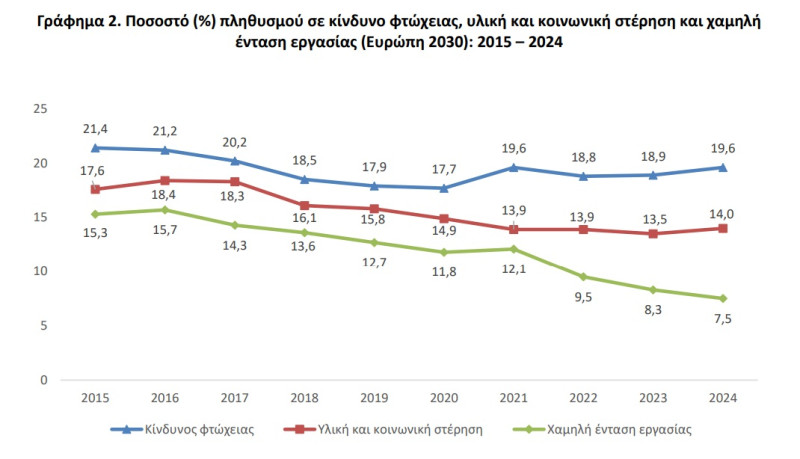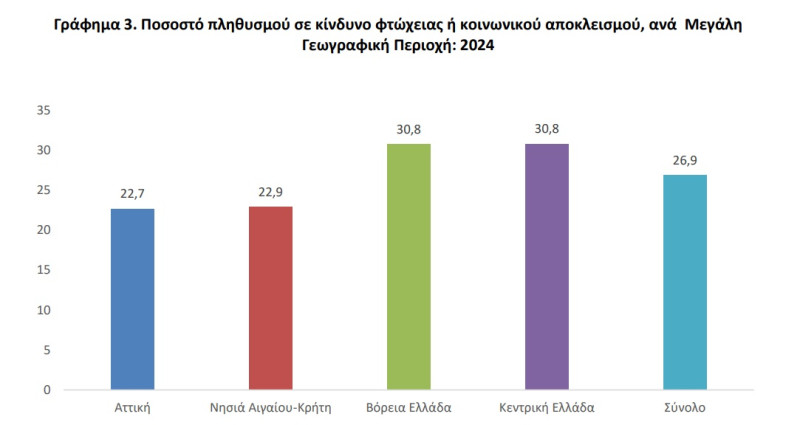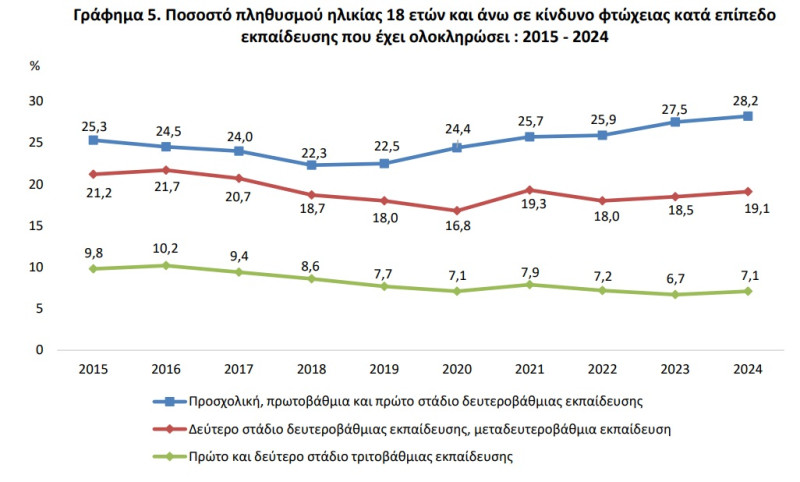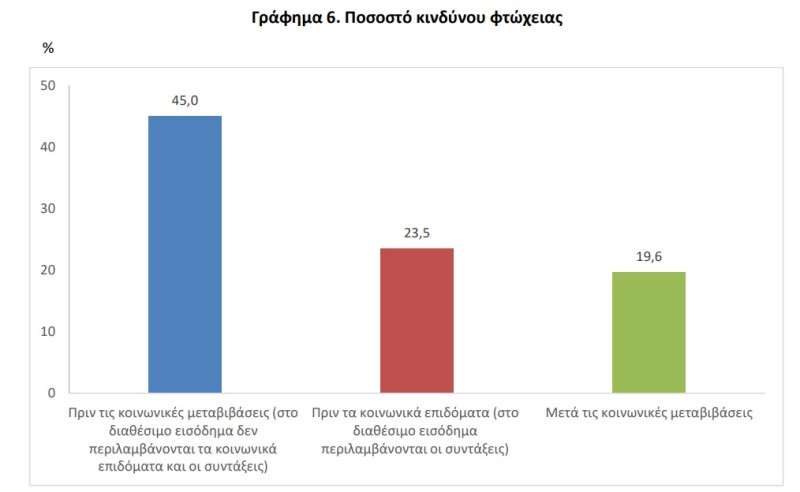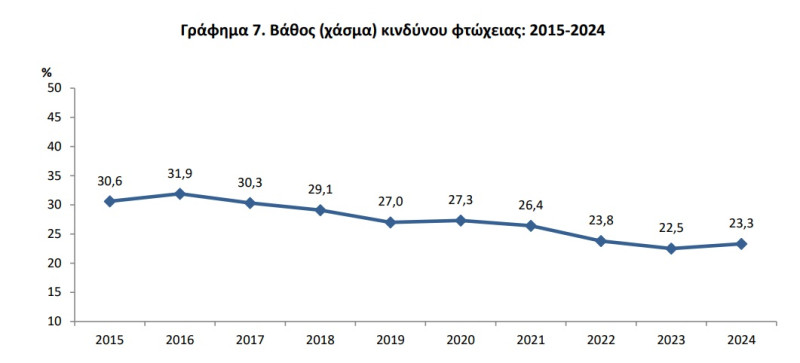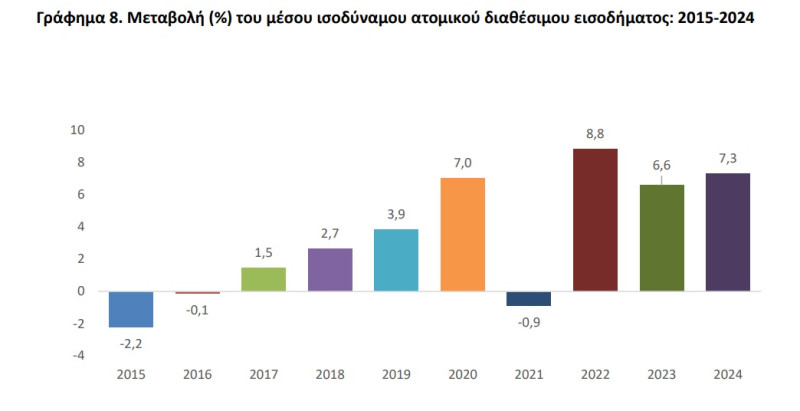Social benefits and pensions, if calculated in the total disposable household income, reduce the rate of poverty risk by 25.4 percentage points.
The population in Greece, which is at risk of poverty or social exclusion, was slightly increased in 2024, as evidenced by the Research and Living Treaties of Households (SILC), 2024, with income reference period in 2023, of the Greek Statistical Authority.
In particular, based on survey data, this figure is 26.9% (2,740,051 people), increasing by 0.8 percentage points compared to 2023 (26.1%).
Increasing the risk of poverty or social exclusion risk (an index composed by the individual indicators of the risk of poverty, material and social deprivation and low work intensity) is due to the increase in rates of both the risk of poverty, to 19.6% in 2024 from 18.9% in 202 2024 from 13.5% in 2023.
The risk of poverty or social exclusion is higher in the case of children aged 17 years and below (27.9%), but it is encouraging that this figure has decreased compared to 2023, which was 28.1%.
The percentage of the 18-64-year-olds living in low-intensity households is estimated at 8.6% of the total population of this age group, showing a decrease of 0.9 percentage points compared to 2023. The percentage for men is 7.6% and for women to 9.7%.
At a geographical level, the lower rates of risk of poverty or social exclusion are recorded in the geographical areas – Nuts 1 – of Attica and the Aegean and Crete islands, while the highest rates are recorded in northern Greece and central Greece.
The percentage of the risk of poverty or social exclusion of households with an adult and at least one dependent child is 43.7%, while households with dependent children is 28.9%and households without dependent children at 20.6%.
The population at the risk of poverty or social exclusion living in a privately owned house with financial liabilities is 22.0%, a privately owned home with no financial liabilities at 24.6%, while in a rented house of 32.2%.
Where is the poverty threshold located
The poverty threshold amounts to EUR 6,510 per year for a single household and € 13,671 for households with two adults and two dependent children under 14 years of age.
Specifically, the poverty threshold is set at 60% of the interstitial equivalent of households available, which was estimated at 10,850 euros, while the average annual income of households in the country was estimated at 20,103 euros.
In the year 2024 (income reference period in 2023), 19.6% of the country’s total population was at risk of poverty after social transfers, increasing by 0.7 percentage points compared to the previous year.
More specifically, households at risk of poverty are estimated at 842,421 out of a total of 4,298,067 households and their members at 1,996,833 in total of 10,187,923 of the country’s estimated population living in private households.
The risk of poverty after social transfers, for children aged 0-17 years (child poverty) is 22.4%, increasing by 0.6 percentage points compared to 2023 (21.8%), while for ages of 18-64 years and 65 years and over 19.1% (18.6%).
The risk of poverty, calculated with thresholds other than 60% of the median total available equivalent income, amounts to:
– 7.0%, if the threshold is set to 40% of the median total available equivalent income,
– 11.8%, if the threshold is set to 50% of the median total available equivalent income and,
– 25.9%, if the threshold is set to 70% of the median total available equivalent income, respectively.
Of particular interest is the fact that the higher the level of education, the lower the rate of poverty risk. For the year 2024, the risk of poverty is estimated at 28.2% for those who have completed preschool, primary and the first stage of secondary education, at 19.1% for those who have completed the second stage of secondary education and post -secondary education, and 7.1% for secondary education.
Employees 18 years and older face a lower risk of poverty compared to the unemployed and financially unable. Specifically, the poverty risk rate for workers 18 years or older is 10.5%, increasing by 0.6 percentage points compared to 2023. Decrease by 0.1 percentage points showed the poverty risk for working women 18 years and over, and increased by 1.1 percentage percentage. 7.3% and 12.9%.
For the unemployed, as already mentioned, the risk of poverty is significantly higher and is 49.2%, showing a significant difference between men and women (61.0% and 40.7% respectively).
The risk of poverty for those who are financially uninformed (not including pensioners) increased by 0.5 percentage points compared to 2023 and amounted to 31.9%.
The poverty risk for workers 18-64 is 10.5%, increasing by 0.7 percentage points compared to 2023. The rate of poverty risk for working women 18-64 years remained stable (7.3%), while an increase of 1.2 percentage of 18 12.9%.
The risk of poverty for full -time workers is 9.8%, while part -time employees is 20.6%.
Social transfers and risk of poverty
The rate of poverty risk before all social transfers (ie, not including social benefits and pensions in the total household income available) is 45.0% and when only pensions and not social benefits are included, it is reduced to 23.5%.
Regarding social benefits, it is noted that these include social aid benefits (such as minimum guaranteed income, housing allowance, heating allowance, etc.), family allowances (such as child allowances), as well as allowances or unemployment allowances or unemployment, or unemployment,
The rate of poverty risk after social transfers is 19.6%, therefore it is found that social benefits help reduce the rate of poverty risk by 3.9 percentage points while then pensions by 21.5 percentage points.
Overall, all social transfers reduces the rate of poverty risk by 25.4 percentage points.
Depth (gap) of the risk of poverty
For the year 2024, the depth (gap) of poverty risk amounted to 23.3% of the poverty risk threshold, increasing compared to the previous year (Graph 7, Table 13). On the basis of this percentage, 50% of the poor are estimated to have an income of less than 76.7% of the poverty risk threshold (which amounts to EUR 6,510), that is, below 4,993 euros per person per person.
The depth (gap) of poverty risk in 2016 amounted to 31.9%, marking the maximum price of recent years. Since then, it has declined, except in the year 2020, which has increased by 0.3 percentage points compared to 2019, and in 2024, when it was 23.3%, increasing by 0.8 percentage points compared to 2023.
Comparison with 2008 and 2019
The risk of poverty after social transfers calculated with the poverty threshold at a steady time ─ and specifically in 2008 and 2019 – is an indication of whether the level of living for lower incomes is improved over time. The purpose of this comparison is to record how the risk of poverty changes into absolute rather than related terms, that is, when the poverty threshold remains stable over time in terms of real purchasing power.
The percentage of the population at risk of poverty for the year 2024 calculated by the poverty threshold of 2008 (ie the percentage of people living in households, whose total equivalent income in the year 2024 is below 60% of the equivalent of 2008 in 2008. Consumer), estimated at 31.2%.
This means that 31.2% of the population of 2024 would be ranked as exposed to the risk of poverty based on 2008 conditions (Table 14). Women record a higher rate than men (32.4%versus 30.1%), while the age group with the highest rate (35.1%) is that of children up to 17 years.
The percentage of the population at risk of poverty for the year 2024 calculated with the poverty threshold of 2019 (ie the percentage of people living in households whose total equivalent income in the year 2024 is below 60% of the 2019 equivalent income of 2019. Consumer), estimated at 12.8%. Therefore, 12.8% of the population of 2024 would be ranked as exposed to the risk of poverty based on the 2019 conditions.
Women record a higher rate than men (13.1%versus 12.4%), while the age group with the highest rate (14.5%) is that of children up to 17 years.
Evolution of household income
13.3% of households said their incomes increased in the last twelve months, 10.2% of households said that 76.6% of households were reduced that it remained the same (Table 16).
The average equivalent individual disposable income amounted to EUR 12,391, increased by 7.3% compared to the previous year. Graph 8 shows the evolution of income from 2015 to 2024.
Source: Skai
I am Janice Wiggins, and I am an author at News Bulletin 247, and I mostly cover economy news. I have a lot of experience in this field, and I know how to get the information that people need. I am a very reliable source, and I always make sure that my readers can trust me.


